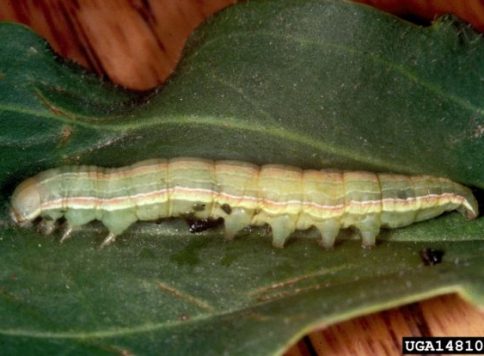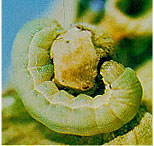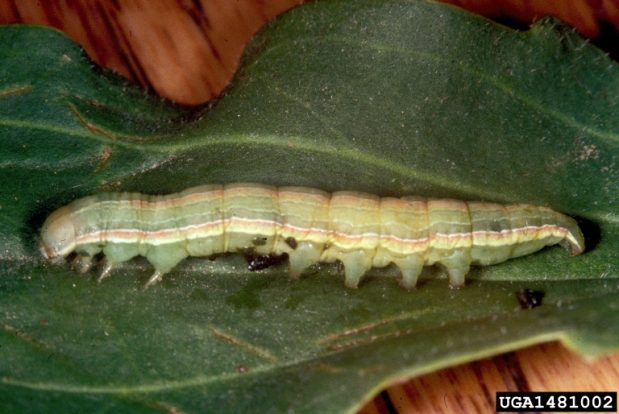

bassiana conidiospores than larvae of L 4. The larvae of L 3 were more susceptible to the treatment with B. Larval mortality increased by increasing the conidiospore concentrations. Do not apply within 25 ft of an aquatic habitat, 150 ft if applied by air.A local isolate of the fungus Beauveria bassiana was tested against the beet armyworm Spodoptera exigua (Hübner) (Lepidoptera: Noctuidae) larvae reared on artificial diet. Do not exceed 0.15 lb ai/a (Mustang Max) or 0.3 lb ai/a (Mustang) per year.
zeta-cypermethrin (Mustang Mustang Max) at 0.008 to 0.025 lb ai/a (Mustang Max) or 0.016 to 0.05 lb ai/a (Mustang). Follow resistance management procedures on the label. Do not exceed six applications or 0.094 lb ai/a per season. spinetoram (Radiant SC) at 0.0313 to 0.0625 lb ai/a. Do not apply more than 36 fl oz/a per season. 
PHI 14 days to harvest, feeding vines, or hay. methomyl (Lannate SP) at 0.45 to 0.9 lb ai/a.malathion (numerous products) at 1.5 lb ai/a.Do not apply within 25 ft of an aquatic habitat, 150 ft if applied by air.
 lambda-cyhalothrin (Warrior II) at 0.015 to 0.03 lb ai/a. esfenvalerate (Asana XL) at 0.03 to 0.05 lb ai/a. Toxic to bees, fish and aquatic invertebrates. Do not feed treated vines or hay to livestock. beta-cyfluthrin (Baythroid XL, Tombstone Helios) at 0.0065 to 0.025 lb ai/a. Some formulations are OMRI-listed for organic use. Add an appropriate spreader-sticker to enhance control. Bacillus thuringiensis (Javelin)-See product labels for rates. acephate (numerous products) at 0.75 to 1 lb ai/a. Management-chemical control: COMMERCIAL USE spinosad-Some formulations are OMRI-listed for organic use. pyrethrins (often combined with other ingredients)-Some formulations are OMRI-listed for organic use. plant essential oils (rosemary, etc.)-Some have demonstrated efficacy against lepidopteran larvae. insecticidal soap-Some formulations are OMRI-listed for organic use. carbaryl-To avoid harming bees, do not apply products containing carbaryl to plants in bloom. kurstaki ( Bt)-Some formulations are OMRI-listed for organic use. azadirachtin (neem oil)-Some formulations are OMRI-listed for organic use. Scratch the soil at the base of plants to find larvae in the daytime. Home gardeners: Control weeds, grasses, and debris in the vegetable garden that provide cover hand-pick cutworm larvae, using a flashlight (as they are nocturnal) to find them, if practical. Fall tillage can help destroy overwintering pupae. Lambsquarters and wild mustard attract egg-laying females and provide a source of food for larvae. Pest description, crop damage and life history Western yellowstriped armyworm ( Spodoptera praefica)
lambda-cyhalothrin (Warrior II) at 0.015 to 0.03 lb ai/a. esfenvalerate (Asana XL) at 0.03 to 0.05 lb ai/a. Toxic to bees, fish and aquatic invertebrates. Do not feed treated vines or hay to livestock. beta-cyfluthrin (Baythroid XL, Tombstone Helios) at 0.0065 to 0.025 lb ai/a. Some formulations are OMRI-listed for organic use. Add an appropriate spreader-sticker to enhance control. Bacillus thuringiensis (Javelin)-See product labels for rates. acephate (numerous products) at 0.75 to 1 lb ai/a. Management-chemical control: COMMERCIAL USE spinosad-Some formulations are OMRI-listed for organic use. pyrethrins (often combined with other ingredients)-Some formulations are OMRI-listed for organic use. plant essential oils (rosemary, etc.)-Some have demonstrated efficacy against lepidopteran larvae. insecticidal soap-Some formulations are OMRI-listed for organic use. carbaryl-To avoid harming bees, do not apply products containing carbaryl to plants in bloom. kurstaki ( Bt)-Some formulations are OMRI-listed for organic use. azadirachtin (neem oil)-Some formulations are OMRI-listed for organic use. Scratch the soil at the base of plants to find larvae in the daytime. Home gardeners: Control weeds, grasses, and debris in the vegetable garden that provide cover hand-pick cutworm larvae, using a flashlight (as they are nocturnal) to find them, if practical. Fall tillage can help destroy overwintering pupae. Lambsquarters and wild mustard attract egg-laying females and provide a source of food for larvae. Pest description, crop damage and life history Western yellowstriped armyworm ( Spodoptera praefica)







 0 kommentar(er)
0 kommentar(er)
